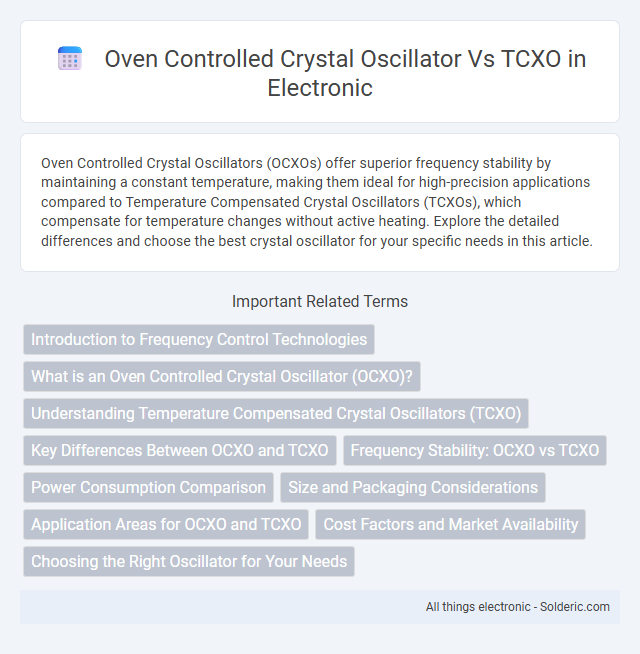Oven Controlled Crystal Oscillators (OCXOs) offer superior frequency stability by maintaining a constant temperature, making them ideal for high-precision applications compared to Temperature Compensated Crystal Oscillators (TCXOs), which compensate for temperature changes without active heating. Explore the detailed differences and choose the best crystal oscillator for your specific needs in this article.
Comparison Table
| Feature | Oven Controlled Crystal Oscillator (OCXO) | Temperature Compensated Crystal Oscillator (TCXO) |
|---|---|---|
| Frequency Stability | +-0.1 ppb to +-10 ppb | +-0.5 ppb to +-50 ppb |
| Temperature Range | Typically -40degC to +85degC with oven control | Typically -40degC to +85degC with compensation |
| Power Consumption | High (due to oven heating) | Low (temperature compensation circuitry) |
| Warm-up Time | Several minutes (oven stabilization) | Instant to a few seconds |
| Size | Large (due to oven and insulation) | Compact |
| Cost | High | Moderate to low |
| Application | High precision timing, laboratory standards, telecom | Mobile devices, GPS, communication equipment |
Introduction to Frequency Control Technologies
Oven Controlled Crystal Oscillators (OCXOs) maintain frequency stability by heating the crystal to a constant temperature, minimizing frequency drift caused by environmental changes. Temperature Compensated Crystal Oscillators (TCXOs) adjust frequency based on temperature variations using compensation circuits, offering stability without the high power consumption of OCXOs. Your choice between OCXO and TCXO depends on the required precision, power availability, and application environment.
What is an Oven Controlled Crystal Oscillator (OCXO)?
An Oven Controlled Crystal Oscillator (OCXO) is a high-precision frequency control device that maintains its crystal oscillator at a constant elevated temperature within a built-in oven to minimize frequency drift caused by temperature variations. OCXOs provide superior frequency stability compared to Temperature Compensated Crystal Oscillators (TCXOs), achieving stability typically in the range of +-0.01 to +-0.1 parts per billion (ppb). This makes OCXOs ideal for applications requiring ultra-stable timing, such as telecommunications, GPS systems, and precision test equipment.
Understanding Temperature Compensated Crystal Oscillators (TCXO)
Temperature Compensated Crystal Oscillators (TCXO) maintain oscillator frequency stability by adjusting for temperature variations through integrated compensation circuits, making them more compact and efficient than Oven Controlled Crystal Oscillators (OCXO). Unlike OCXO, which use a heated chamber to stabilize the crystal temperature, TCXOs rely on temperature sensors and electronic compensation, offering improved energy efficiency and faster start-up times. Your choice between TCXO and OCXO depends on the required frequency precision, power consumption, and application-specific environmental conditions.
Key Differences Between OCXO and TCXO
Oven Controlled Crystal Oscillators (OCXOs) maintain frequency stability by housing the crystal in a temperature-controlled oven, ensuring minimal frequency drift even in varying temperatures. Temperature Compensated Crystal Oscillators (TCXOs) rely on electronic temperature compensation without the need for an oven, offering moderate accuracy with lower power consumption and smaller size. OCXOs are preferred in high-precision applications requiring ultra-stable frequency, while TCXOs are suitable for portable and cost-sensitive devices needing reasonable temperature stability.
Frequency Stability: OCXO vs TCXO
Oven Controlled Crystal Oscillators (OCXOs) provide superior frequency stability, maintaining variations within parts per billion (ppb) by operating the crystal at a constant elevated temperature in a temperature-controlled chamber. In contrast, Temperature Compensated Crystal Oscillators (TCXOs) achieve frequency stability in parts per million (ppm) by applying electronic compensation for temperature changes rather than stabilizing the crystal temperature itself. OCXOs are preferred in applications demanding ultra-high precision and minimal frequency drift, while TCXOs offer a cost-effective solution suitable for moderate stability requirements.
Power Consumption Comparison
Oven Controlled Crystal Oscillators (OCXOs) consume significantly more power than Temperature Compensated Crystal Oscillators (TCXOs) due to the internal heating element required to maintain a constant temperature for improved stability. TCXOs, in contrast, achieve temperature compensation through electronic adjustment, resulting in lower power consumption ideal for battery-operated or energy-sensitive applications. Your choice between the two depends largely on the balance between performance needs and power efficiency.
Size and Packaging Considerations
Oven Controlled Crystal Oscillators (OCXOs) typically feature larger and heavier packages due to their integrated heating elements and thermal insulation, which require more space for stable temperature control. In contrast, Temperature Compensated Crystal Oscillators (TCXOs) are designed with compact and lightweight packaging, making them ideal for space-constrained applications such as mobile devices and handheld radios. The size difference significantly impacts the choice between OCXO and TCXO, depending on the application's need for stability versus miniaturization.
Application Areas for OCXO and TCXO
Oven Controlled Crystal Oscillators (OCXOs) find primary application in telecommunications, satellite systems, and precision instrumentation where ultra-stable frequency reference is crucial. Temperature Compensated Crystal Oscillators (TCXOs) are widely used in mobile devices, GPS receivers, and wireless communication modules due to their balance of stability and low power consumption. Both OCXOs and TCXOs serve critical roles in timing-sensitive applications but differ in performance requirements and environmental conditions.
Cost Factors and Market Availability
Oven Controlled Crystal Oscillators (OCXOs) generally incur higher manufacturing and operational costs due to their complex thermal stabilization mechanisms compared to Temperature Compensated Crystal Oscillators (TCXOs), which use less expensive temperature compensation circuits. OCXOs offer superior frequency stability essential for high-precision applications, yet their market availability is more limited and typically targeted towards specialized industries such as aerospace and telecommunications. TCXOs dominate mass-market availability, favored for cost-sensitive applications like GPS devices and mobile communications where moderate stability suffices.
Choosing the Right Oscillator for Your Needs
Choosing the right oscillator depends on application requirements such as frequency stability, size, power consumption, and cost. Oven Controlled Crystal Oscillators (OCXOs) offer superior frequency stability of +-0.05 ppb by maintaining a constant temperature in an isolated oven, making them ideal for precision timing in telecommunications and aerospace. Temperature Compensated Crystal Oscillators (TCXOs) provide good stability around +-0.5 to 2.0 ppm at lower power consumption and smaller size, suitable for mobile devices and GPS applications requiring moderate accuracy.
Oven controlled crystal oscillator vs TCXO Infographic

 solderic.com
solderic.com